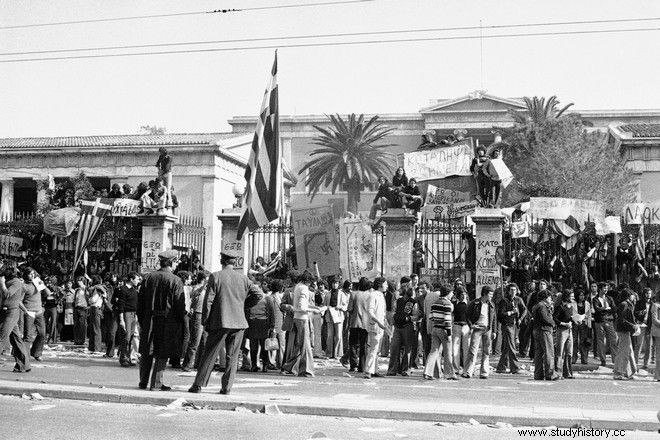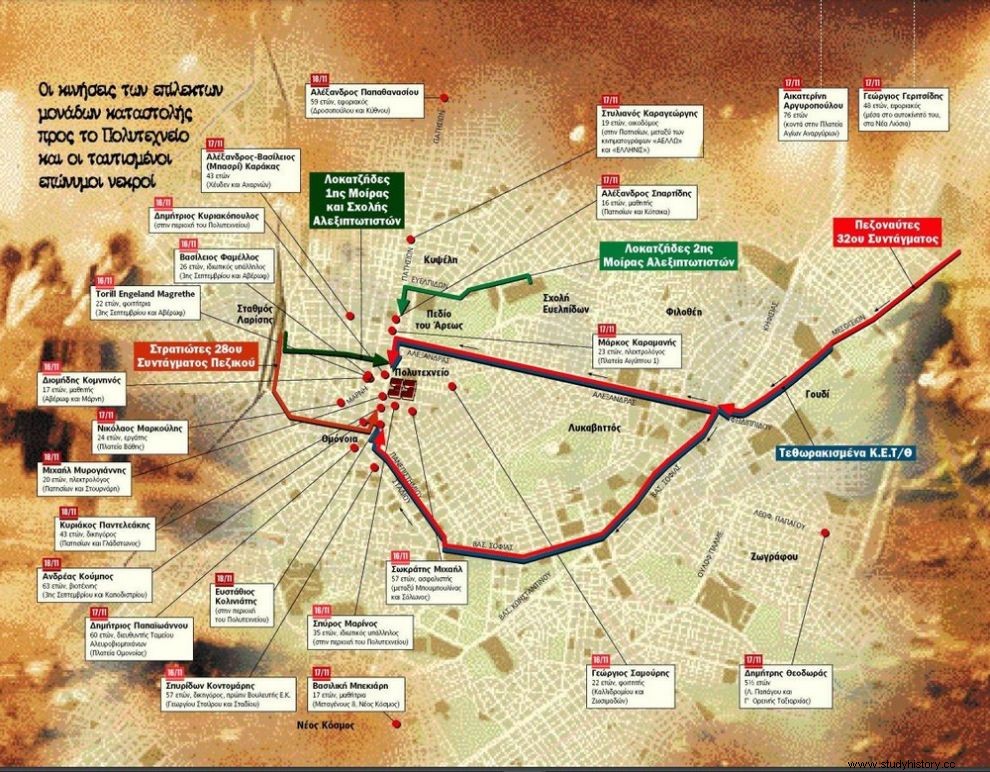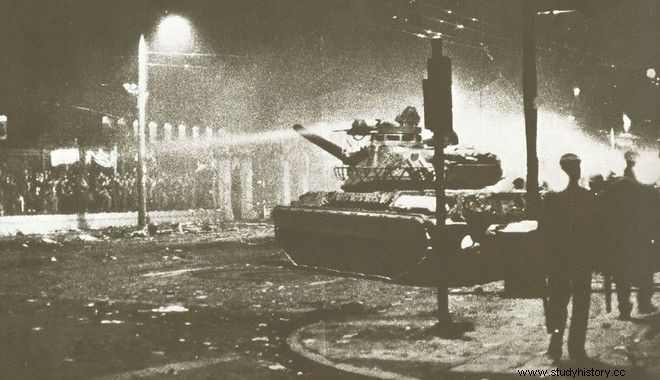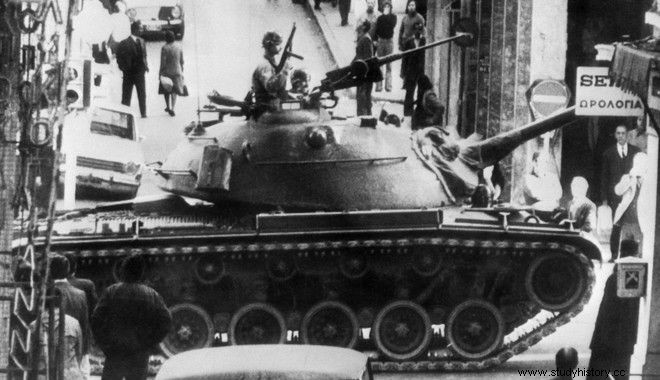We are approaching half a century since the historic November 17, 1973, and yet, on the blood-stained wall where history was written, marking the return of the Republic to our country, the exact number of people who spearheaded the uprising, as a result of which they were killed, is still not formed or be injured inside and outside the Polytechnic.
The question of the exact number of dead from the uprising is brought up every year, on such a day, but to this day it is an unclear field with "blurry" or - not even - documented data, inaccuracies, as well as anecdotal claims.
In an effort to dispel the myths and clarify the facts, the National Research Foundation, brought to light important findings, "Documenting the events of November 1973", as was the title of a major investigation starting in 2002, in the context of which a scientific gathering is attempted and processing of evidence for different parameters of the events:The timeline of the rebellion, the operational plan for its suppression, the development of the events outside the Polytechnic, etc.
Among them the number and the identity of the dead and wounded of the uprising, as recorded in "Polytechneio '73:The issue of victims:Dead and wounded" by Leonidas Kallibretakis (2004, Filippotis publications), who commemorated the dead and responded to those nostalgic for totalitarian regimes through a documented record.
After all, the goal of the research, as characteristically written by Leonidas Kallibretakis (then member of the Student Struggle Committee and president of the Assembly of the Faculty of Philosophy) was to put an end to a period of silence that "discredits" the rebellion, demeans the memory of the real victims and leaves room for the indirect or direct "revisionists" of history to talk about "fairy tales of the Left" and about "2-3 dead from stray bullets "".

Anniversary of Polytechnic University:From 1973 until today...
Down to the end of the thread and the citation of the "documented cases", the research makes a historical record of the intervening years and decades, during which lists and depositions had to be revised, redacted or discarded.
To be precise, it was in September 1974 when "prosecutor Dimitrios Tseva was assigned to conduct a preliminary examination", characteristically writes Mr. Kallibretakis, at the same time justifying the scope of the examination from the depositions as well as the rumors of that period, to refutation, of course, of the announcements by the junta that spoke, initially of 2 and then of only 15 dead.
So, the following retrospective is made:From the list of 59 names of the journalist Grigoriou Papadatos (17/11), the statements of the military officer Pantelis Tsagournis who stated that he saw a relevant report (in the Staff of colonel Dertiliis) in which "423 dead" were mentioned to then reconstruct, speaking of "423 dead or injured", the revelations of "the former KYP agent, Dimitrios Pimba" who spoke of "450 dead" and of "mass graves", until the final conclusion Tseva (14/10 /1974) where he estimated that the number of dead could reach 34 (18 named and 16 anonymous).
In order for the investigation to naturally end in the -so far- record of 24 dead, with full name, age, status, day, time, even the place where they lost their lives.

At the same time, as it is typically mentioned, a list of sixteen (16) anonymous cases has been compiled that had been considered at some point in the process to "reliably appear" as dead, from official, named and relatively reliable statements, with specific data.
Finally, the research has put under the microscope thirty (30) named cases, which persistently appear in most catalogs from 1974 until today, without ever being documented. "All these anonymous and controversial named cases remain pending, in order to be further investigated, before a final decision is made to adopt or reject them".
The "unknown" account of the injured
However, if the "Question of the victims", which is the title of Leonidas Kallibretakis' work, remains "unsolved", as he describes it in his preface, one realizes how difficult it is to accurately record, or even approach, the people who were injured.
This is the second part of the investigation that attempts to shed light on the deep and uncharted waters of the account of the wounded during the uprising.

From the preliminary investigation, it is said that 1,103 injured people were certified, based on the reports sent to him by hospitals, clinics and some individual doctors: "The number of injured people is truly great. of Hospitals, Clinics and Doctors, the officially known wounded of the bloody three-day period from November 16 to 19, 1973 amount to one thousand one hundred and three (1,103) citizens", is characteristically referred to in the Tseva finding. To this tally, however, as he himself admitted, should be added "an unspecified number of other citizens", who", "or fleeing from the doctors, or convalescent homes, or even fleeing to no one for hospitalization, fearing apparently unpleasant for them or the families of the developments", conveys the relevant research, in one of the assumptions that prove that the number of injured was much higher:
Depositions were received from at least some of these victims, as the examination of the respondents will take a long time, the disposition of which is outside the scope of the preliminary investigation conducted by me
In fact, the order of the then head of the Armed Forces, General Zagorianakos, is recorded, which expressly forbade the "temporary home care of persons not living with the family or providing care to them, if this not reported - within three hours to the relevant police authority", conveying the climate in which the dramatic events unfolded. With the exception, as mentioned in the Tseva opinion, the "encouraging exceptions of "acts of philanthropy and humanitarianism", with doctors, nurses and ordinary people from the surrounding areas running to the Polytechnic "subject to the voice of their humanitarian and medical duty". These, in in contrast to the conditions encountered by the wounded at the General Hospital of Athens, where "o the wounded are not the object of treatment and care there, but the target of cannibalistic events on the part of unruly, self-employed, police officers, under the blessings and encouragement of the then administrative Director of the Hospital".

Given the conditions, as well as the absence of official records, the estimates mentioned in the research reach around 2,000 wounded, a number that is characterized as "conservative", if compared to corresponding cases of the period such as French May of 1968, American Anti-War Movement 1968-1970 , since "in all those cases, the non-hospitalized were always multiple times the hospitalized, and indeed in regimes where the disincentive for hospitalization, i.e. the possibility of prosecutions against the injured who would seek treatment, was presumably smaller, than in the case of Greece in 1973", says the survey.
From 16 years old and up to... 123 cases of shootings
In the chapter of the injured, apart from the account that remains unknown, some individual elements are of particular interest in terms of the profile of the people who spearheaded the events and were affected during them.
As the survey reports, in terms of professional status, the largest percentage were craftsmen (26.7%), followed by students (17.1%), followed by private employees (15.8%) and students (10.3%) . In terms of age, the majority belonged to 22-year-olds (13.3%), 16-year-olds (12.8%) and 20-year-olds (12.7%), followed by those who were 18 and 24 years old (9%).

Through the processing of the conditions of their injury, the intensity of the conflicts was assessed temporally and locally, with the place and time being combined with the way of injury (glops, tear gas, bullets, etc.), thus giving a picture and about the course of the repression operation.
"Deputy prosecutor Ioannis Zaginis, in his submission to the Appeals Council in 1975, without having full data on all the injured, considered that in at least 124 cases there was a clear homicidal intent on the part of the repression forces. These are mainly cases in which the injury resulted from the use of firearms, states the research, to conclude by quoting the results of a statistical analysis of the perpetrators (military, police, etc.), through the cases that were considered homicides and attempted homicides and based on which " The Security Forces were ahead of the Army in both these fields (54% vs. 46% in homicides and 64% vs. 36% in attempts" .
THE VICTIMS OF THE POLYTECHNIC
The 24 fully documented cases
1. Spyridon Kontomaris of Anastasios, 57 years old , lawyer (former member of parliament of Corfu of the Center Union), resident of Agios Meletios, Athens. On 16.11.1973, around 20.30-21.00, while he was at the intersection of Georgiou Stavros and Stadiou streets, he was injured by tear gas fired by the Police against the demonstrators, as a result of which he suffered a myocardial infarction. He was taken to the E.E.S. First Aid Station, where he was pronounced dead.
2. Diomedes Komnenos of John, 17 years old, student, resident of Lefkados 7, Athens. On 16.11.1973, between 21.30 and 21.45, while he was with other demonstrators at the intersection of Averof &Marni streets, he was mortally wounded in the heart by shots fired at him by the guards of the Ministry of Public Order. He was transferred to the First Aid Station of the E.E.S. and from there, now dead, to the Athens Regulatory Center (as the General State Hospital was then called).
3. Socrates Michael, 57 years old, insurance company expert, resident of Peristeri, Attica. On 16.11.1973, between 9:00 p.m. and 10:30 p.m., while he was between Bouboulinas and Solonos streets, he was injured by tear gas fired by the Police against the demonstrators, as a result of which he suffered an occlusion of the left coronary artery. He was taken half-dead to the First Aid Station of the E.E.S. (F September), where he died.
4. Per Reidar's Toril Margrethe Engeland, 22, student from Molde, Norway. On 16.11.1973, around 23.30, he was mortally wounded in the chest by fire from the guards of the Ministry of Public Order. She was taken by protesters to the "Acropolis" hotel and later, already dead, to the First Aid Station of the I.K.A. He was initially inaccurately reported by the Police as "Egypt Turil Teklet" and this misunderstanding still survives on some "death lists".
5. Vasilios Famellos of Panagiotis, 26 years old, private employee, from Pyrgos Ilias, resident of Kasos 1, Kypseli, Athens. On 16.11.1973, around 23.30, he was fatally wounded in the head by fire from the guards of the Ministry of Public Order. He was taken by protesters to the First Aid Station of the E.E.S. and from there, now dead, to the Athens Regulatory Center.
6. Georgios Samouris of Andreas, 22 years old, student of Pantei, from Patras, resident of 7 Kountouriotou Square, Koukaki. On 16.11.1973 around midnight, while he was in the wider area of the Polytechnic (Kallidromi and Zosimados), he was mortally wounded in the neck by police fire. He was taken to the emergency clinic of the Polytechnic, where he died. From there he was transferred to the First Aid Station of the I.K.A. He had initially been inaccurately referred to by the Police as "Hamourlis".
7. Dimitrios Kyriakopoulos of Antonio, 35 years old, builder, from Kalavryta, resident of Peristeri, Attica. During the evening hours of 16.11.1973 while he was in the area of the Polytechnic, he was attacked by tear gas and then beaten by police officers with solid batons, as a result of which he died, from an acute rupture of the aorta, three days later, on 19.11.1973, while being transported at the E.E.S.
First Aid Station8. Spyros Marinos of Dionysios, called Georgaras, 31 years old, private employee, from Zakynthos Abroad. During the evening hours of 16.11.1973, while he was in the area of the Polytechnic, he was beaten by policemen with solid rods, and suffered cranio-encephalic injuries. He was transferred to the Penteli Hospital, where he died on Monday, 19.11.1973, from an acute stroke. He was buried in his hometown, where on 9.9.1974, a ceremony was held in his memory.
9. Nikolaos Markoulis of Petros, 24 years old, worker, from Partheni, Thessaloniki, resident of Christomanou 67, Sepolia, Athens, worker. During the morning hours of 17.11.1973, while walking in Vathis Square, he was wounded in the abdomen by a burst of military patrol. He was transferred to the Athens Regulatory Center, where he died on Monday 11/19/1973.
10. Aikaterini Argyropoulou, wife of Aggeli, 76 years old resident of Kennedy and Kalymnos, Agioi Anargyroi Attica. At 10.00 on 17.11.1973, while she was in the yard of her house, she was wounded in the back by a bullet. She was admitted to the "Pammakaristos" clinic (Kato Patisia), where she was hospitalized for a month and then transferred to her home, where she died as a result of her injuries after six months (May 1974).
11. Stylianos Karageorgis of Agamemnon, 19 years old, builder, resident of Miaouli 38, Neo Heraklion, Attica. At 10.15 in the morning of 17.11.1973, while he was with other demonstrators on Patision Street, between the "AELAO" and "EALINIS" cinemas, he was injured by a burst of machine gun fired at the marine patrol that was riding in an armored vehicle. He was transferred to K.A.T., where he died after 12 days, on 30.11.1973.
12. Markos Karamanis of Dimitrios, 23 years old, electrician, from Piraeus, resident of Chios 35, Aegaleo. At approximately 10:30 in the morning of 17.11.1973, while he was on the roof of an apartment building on Egypt Square 1, he was mortally wounded in the head by fire from the military guard who was stationed on the roof of the OTE. (author Ioannis Aumperis, 573rd Infantry Battalion). He was taken to the "Pantanassa" clinic (Victoria Square), where he was pronounced dead.
13. Alexandros Spartidis of Efstratiou, 16 years old, student, from Piraeus, resident of 80 Agia Lavra, Athens. At around 10.30 to 11.00 on the morning of 17.11.1973, while he was walking at the intersection of Patisia and Kotsika streets, he was mortally wounded in the abdomen by fire from the military guard who was in ambush on the roof of the OTE. (author Ioannis Dimberis, 573rd Infantry Battalion). With a piercing wound, he was taken to the hospital, where his father found him dead.
14. Dimitrios Papaioannou, 60 years old director of the flour industry fund, resident of Aristomenouis 105, Athens. Around 11.30 on 17.11.1973, while he was in Omonia square, he was attacked by tear gas fired by the Police. He was taken to the First Aid Station of the E.E.S., where he was pronounced dead, as a result of a heart attack.
15. George Geritsidis of Alexandrou, 47 years old, tax official, resident of Elpidos 29, Neo Heraklion, Attica. At 12.00 on 17.11.1973, while he was in his car in Nea Liosia, he was mortally wounded in the head by shots that crossed the sky of the car. He was transferred to the Athens Regulatory Center, where he died the same day.
16. Vasiliki Bekiari of Foti, 17 years old , working student, from Ampelakia Valtos, Etoloakarnania, resident of Metagenous 8, Neos Kosmos. At 12.00 noon on 17.11.1973, while she was on the roof of her house, she was mortally wounded in the neck by gunfire. He was transferred to the Athens Regulatory Center and then to "Evangelismos", where he died the same day.
17. Dimitris Theodoras of Theophanos, 52 years old, resident of Anakreonto 2, Zografou. At 1:00 p.m., on 17.11.1973, while crossing with his mother the intersection of Orinis Taxiarchias Street and Papagou Avenue in Zografou, he was mortally wounded in the head by fire from a military patrol led by an officer (probably Major General Spyridon Stathakis of the K.E.T. /Θ), which was built on top of the hill of Agios Therapontos. He expired instantly and was pronounced dead when he was taken to Children's Hospital.
18. Αλέξανδρος Βασίλειος (Μπασρί) Καράκας, 43 ετών, Αφγανός τουρκικής υπηκοότητας, ταχυδακτυλουργός, κάτοικος Μύρων 10, Αγιος Παντελεήμονας, Αθήνα. Στις 13.00, της 17.11.1973, ενώ βάδιζε με τον 13χρονο γιο του στη διασταύρωση των οδών Χέϋδεν και Αχαρνών, τραυματίστηκε θανάσιμα στην κοιλιά από ριπή μυδραλίου τεθωρακισμένου στρατιωτικού οχήματος. Μεταφέρθηκε απευθείας στο νεκροτομείο, όπου διαπιστώθηκε ο θάνατος του.
19. Αλέξανδρος Παπαθανασίου του Σπυρίδωνος, 59 ετών, συνταξιούχος εφοριακός, από το ΚεράσοΒο Αιτωλοακαρνανίας, κάτοικος Νάξου 116, Αθήνα. Στις 13.30 της 18.11.1973, ενώ βάδιζε με τις ανήλικες κόρες του στη διασταύρωση των οδών Δροσοπούλου και Κύθνου, απέναντι από το ΙΣΤ' Αστυνομικό Τμήμα, βρέθηκε εν μέσω πυρών, προερχομένων από τους αστυνομικούς του Τμήματος, με αποτέλεσμα να πάθει συγκοπή. Μεταφέρθηκε στο Σταθμό Πρώτων Βοηθειών, όπου διαπιστώθηκε ο θάνατος του.
20. Ανδρέας Κούμπος του Στέργιου 63 ετών, βιοτέχνης, από την Καρδίτσα, κάτοικος Αμαλιάδος 12, Κολωνός. Γύρω στις 11.00 με 12.00 της 18.11.1973, ενώ βάδιζε στη διασταύρωση των οδών Γ' Σεπτεμβρίου και Καποδιστρίου, τραυματίστηκε στη λεκάνη από πυρά μυδραλίου τεθωρακισμένου στρατιωτικού οχήματος. Μεταφέρθηκε στο Σταθμό Πρώτων Βοηθειών του Ε.Ε.Σ., κατόπιν στο Ρυθμιστικό Κέντρο Αθηνών και τέλος στο Κ.Α.Τ., όπου και πέθανε στις 30.1.1974.
21. Μιχαήλ Μυρογιάννης του Δημητρίου, 20 ετών, ηλεκτρολόγος, από τη Μυτιλήνη, κάτοικος Ασημάκη Φωτήλα 8, Αθήνα. Στις 12.00 το μεσημέρι της 18.11.1973, ενώ βάδιζε στη διασταύρωση των οδών Πατησίων και Στουρνάρη, τραυματίστηκε θανάσιμα στο κεφάλι από πυρά περιστρόφου αξιωματικού του Στρατού (αυτουργός ο συνταγματάρχης Νικόλςος Ντερτιλής). Μεταφέρθηκε στο Σταθμό Πρώτων Βοηθειών του Ε.Ε.Σ. σε κωματώδη κατάσταση και κατόπιν στο Ρυθμιστικό Κέντρο Αθηνών, όπου πέθανε αυθημερόν.
22. Κυριάκος Παντελεάκης του Δημητρίου, 44 ετών, δικηγόρος, από την Κροκέα Λακωνίας, κάτοικος Φερρών 5, Αθήνα. Στις 12.00 με 12.30 το μεσημέρι της 18.11.1973, ενώ βάδιζε στη διασταύρωση των οδών Πατησίων και Γλάδστωνος, τραυματίστηκε θανάσιμα από πυρά διερχομένου άρματος μάχης. Μεταφέρθηκε στο Ρυθμιστικό Κέντρο Αθηνών, όπου και πέθανε στις 27.12.1973.
23. Ευστάθιος Κολινιάτης, 47 ετών, από τον Πειραιά, κάτοικος Νικο-πόλεως 4, Καματερό Αττικής. Κτυπήθηκε στις 18.11.1973 από αστυνομικούς με συμπαγείς ράβδους, και υπέστη κρανιοεγκεφαλικές κακώσεις, συνεπεία των οποίων πέθανε στις 21.11.1973.
24. Ιωάννης Μικρώνης του Αγγέλου, 22 ετών, φοιτητής στο τμήμα Ηλεκτρολόγων Μηχανικών του Πανεπιστημίου Πατρών, από την Ανω Αλισσό Αχαΐας. Συμμετείχε στην κατάληψη του Πανεπιστημίου Πατρών. Κτυπήθηκε μετά τα γεγονότα, υπό συνθήκες που παραμένουν ακόμη αδιευκρίνιστες. Συνεπεία της κακοποίησης του υπέστη ρήξη του ήπατος, εξαιτίας της οποίας πέθανε στις 17.12.1973 στο Λαϊκό Νοσοκομείο Αθηνών, όπου νοσηλευόταν. Σύμφωνα με ορισμένες ενδείξεις, ο τραυματισμός του συνέβη στην Πάτρα, άλλες όμως πληροφορίες τον τοποθετούν στην Αθήνα. Η περίπτωση του παραμένει υπό έρευνα.
ΔΕΙΤΕ ΠΕΡΙΣΣΟΤΕΡΕΣ ΠΛΗΡΟΦΟΡΙΕΣ ΓΙΑ ΤΗΝ ΕΡΕΥΝΑ ΤΟΥ ΕΘΝΙΚΟΥ ΙΔΡΥΜΑΤΟΣ ΕΡΕΥΝΩΝ ΓΙΑ ΤΑ ΓΕΓΟΝΟΤΑ ΤΟΥ ΠΟΛΥΤΕΧΝΕΙΟΥ
